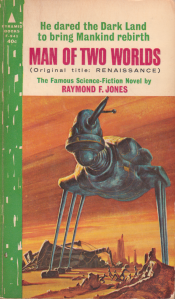The Book: “Pictures Don’t Lie” by Katherine MacLean. Originally published by Galaxy Science Fiction in August 1951. Read in The Diploids and Other Flights of Fancy published by Avon (G-1143) in 1962.

The Setting: Earth, a military base.
The Story: Aliens are coming to Earth! They’re in contact, audio and video, plus they’ve sent some of their sitcoms along too. But once they’ve landed, no one knows where they are…
The Science: Spoiler: The aliens are tiny and move, speak, the whole works, much faster than we do. Though we both use radio waves to communicate. I don’t see why it should be possible for other worldly organisms to perceive and interact with space and time in radically different ways than we do. Hell, it’s a major trope in sciencefiction and super hero stories.
The Reaction: A very good story. It has humor, it’s got a twist, and it’s just fun. I’m not surprised that it was widely adapted into other media.
The Cover: Same as the first time.
Next Up: Foundation by Isaac Asimov.


